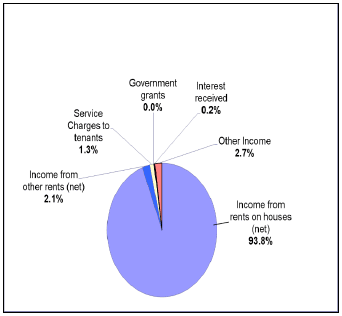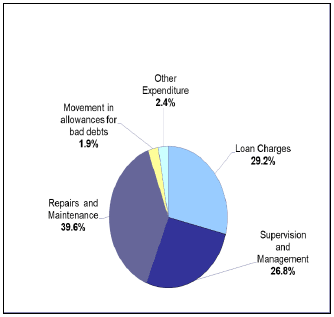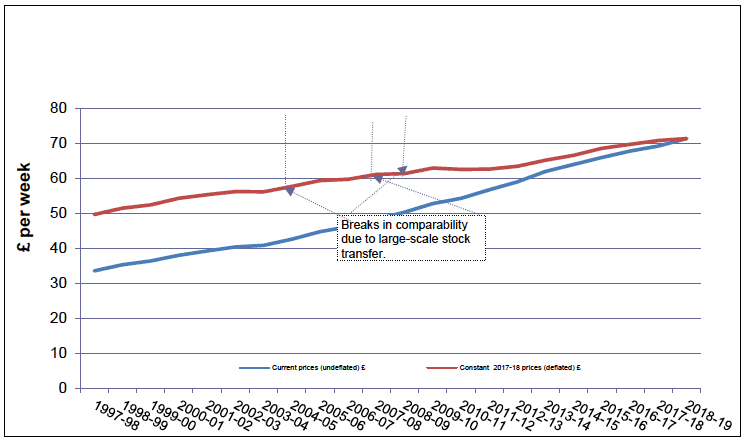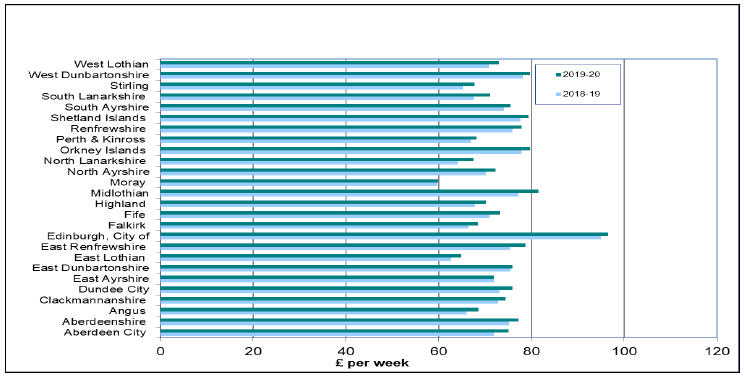Housing Revenue Account (HRA) statistics: Scottish local authority housing income and expenditure 2018-2019 (actuals) and 2019-2020 (estimates)
This bulletin presents statistics on Local Authority housing income and expenditure in Scotland from their Housing Revenue Accounts (HRAs)statistical returns.
Housing revenue income and expenditure (charts 2a & 2b)
10. In 2018-19, rents from council houses account for around 94% of revenue income to the HRAs. Managing and maintaining the houses accounts for nearly 66% of the expenditure, while loan charges (i.e. the cost of servicing housing debt) account for just under 30%.
11. Other sources of income for Local Authorities include rents on hostels and other properties such as garages or lock-ups and also interest and other charges to tenants for special services. Money is also spent on things such as, upkeep of hostels (in some council areas) and other properties, writing-off rent arrears and paying council tax on void properties.
12. The cost of maintaining and managing housing stock is usually less than the income received i.e. council housing makes a revenue surplus at the Scottish level. This remaining income (the surplus) is used to fund capital investment in the council housing stock as part of the Capital Programme. The use of income in this way is known as Capital Funded from Current Revenue (CFCR).
13. In 2018-19 total HRA income (net) totalled just over £1.21bn across Scotland and total expenditure was just over £979m. Further details of expenditure and income are set out in Chart 2(a) and 2(b) below. At year end, when income is compared to expenditure there was a surplus of £234m, £257m was transferred to councils' housing capital expenditure accounts and then invested on housing capital projects including new build council houses and enhancements to existing council stock (in addition to any day-to-day maintenance).
Chart 2(a): Source of HRA revenue income, Scotland, 2018-19

Chart 2(b): HRA revenue expenditure, Scotland, 2018-19

Source:
Scottish Government, Communities Analytical Division - based on Housing Revenue Account return provided by Scottish Local Authorities.
Rent levels and income from rents (charts 3 & 4)
14. In 2018-19 of the 26 Local Authorities with their own housing stock raised a total of just under £1.14bn in income (net of losses from empty properties) from standard rents on dwellings and a further £25m in rent from other HRA properties such as garages.
15. The average rent per dwelling (including both let and un-let properties) was £71 per week in 2018-19[4] an increase of just over £2.00 since 2017-18. In the decade since 2008-09 average rents have increased by £10 or 16% in real terms i.e. over and above general inflation. In 2018-19 there is variation between councils in average rents, from £60 per week in Moray to £97 per week in the City of Edinburgh.
16. These figures may be lower than rents reported in other publications[5] as, rather than taking a weighted average of set rents charged to tenants, they instead reflect the amount earned by the council in respect of each property owned (calculated by dividing the Council's Standard Rental Income on houses by the total letting stock). This method takes into account the proportion of housing which spends some time un-let and those for which rent is not successfully collected.
17. Housing Benefit accounted for a high proportion of council rental income. In 2018-19, rent rebate subsidy for council house tenants was around £519m, representing 45% of total income from standard rents. This has decreased each year since 2014-15 when it was 57%. In 2018-19, rent rebate subsidy as a proportion of standard rents varied from 30% in the East Lothian and Shetland Islands to 60% in Renfrewshire.
Chart 3: Average rent per HRA property per week, Scotland, 1997-98 to 2018-191,2,3,4

Source:
Scottish Government , Communities Analytical Division - based on Housing Revenue Account return provided by Scottish Local Authorities.
Consumer Price Index (source - ONS) CPI all Items Index. (2015 = 100).
Notes:
1. Six councils transferred their housing stock to the housing association sector, therefore HRA information is not available
(n.a.) for them.
2. Dotted lines indicate breaks in comparability following transfer of housing stock as follows:
from 2003-04 transfer of housing stock from Glasgow, Dumfries & Galloway and Scottish Borders,
from 2006-07 transfer of housing stock from Argyll & Bute and Eilean Siar,
from 2007-08 transfer of housing stock from Inverclyde.
3. Current (or nominal) prices are in the value of currency for that particular year. Current price are affected by inflation.
Constant (or real) prices adjust for the effects of inflation and used to measure the true growth of a time series. Constant prices have been deflated using the Consumer Price Index (by ONS).
4. This calculation includes both let and un-let properties and therefore the amount of rent actually paid by is likely to be slightly higher.
Chart 4: Average weekly rent, by Local Authority1, 2018-19 (actual) and 2019-20 (estimated)

Source:
Scottish Government, Communities Analytical Services Division - based on Housing Revenue Account return provided by Local Authorities.
Notes:
1. Six councils transferred their housing stock to the housing association sector, therefore HRA information is not available (n.a.) for them.
Contact
Email: Charles.Brown@gov.scot
There is a problem
Thanks for your feedback